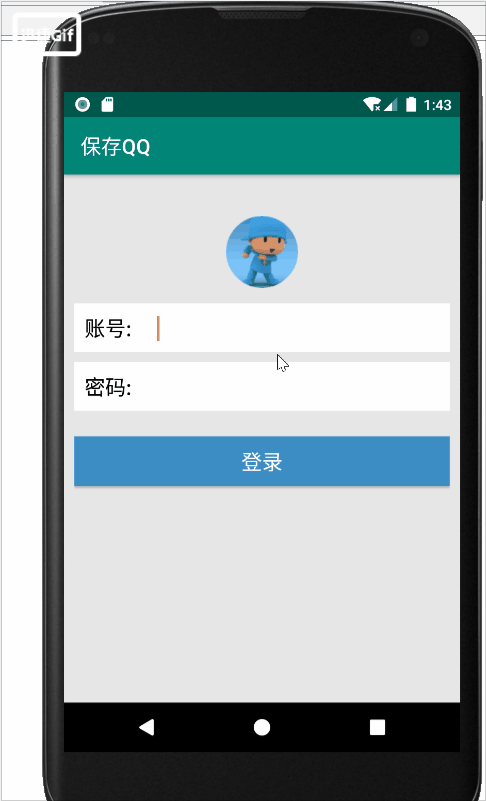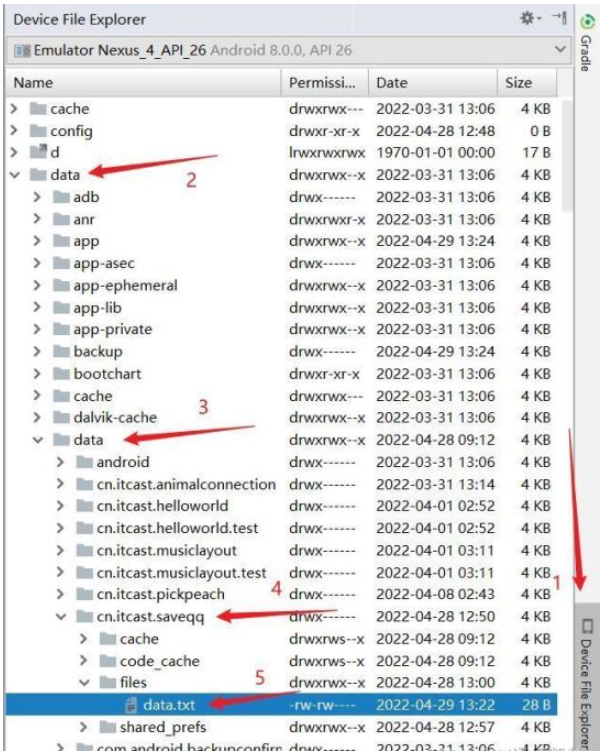您好,登錄后才能下訂單哦!
您好,登錄后才能下訂單哦!
今天小編給大家分享一下Android怎么實現保存QQ賬號與密碼功能的相關知識點,內容詳細,邏輯清晰,相信大部分人都還太了解這方面的知識,所以分享這篇文章給大家參考一下,希望大家閱讀完這篇文章后有所收獲,下面我們一起來了解一下吧。
1)垂直線性布局為整體框架
2)頭像獲取
3)子線性布局編輯框和密碼框
4)登錄button按鈕
<?xml version="1.0" encoding="utf-8"?> <LinearLayout xmlns:android="http://schemas.android.com/apk/res/android" android:layout_width="match_parent" android:layout_height="match_parent" android:background="#E6E6E6" android:orientation="vertical" android:padding="10dp"> <ImageView android:layout_width="70dp" android:layout_height="70dp" android:layout_centerHorizontal="true" android:layout_gravity="center_horizontal" android:layout_marginTop="30dp" android:src="@drawable/head" /> <LinearLayout android:layout_width="match_parent" android:layout_height="wrap_content" android:layout_marginTop="15dp" android:background="@android:color/white" android:orientation="horizontal"> <TextView android:layout_width="wrap_content" android:layout_height="wrap_content" android:padding="10dp" android:text="賬號:" android:textColor="#000" android:textSize="20sp" /> <EditText android:id="@+id/et_account" android:layout_width="match_parent" android:layout_height="wrap_content" android:layout_marginLeft="5dp" android:background="@null" android:padding="10dp" /> </LinearLayout> <LinearLayout android:layout_width="match_parent" android:layout_height="wrap_content" android:layout_marginTop="10dp" android:background="@android:color/white" android:orientation="horizontal"> <TextView android:id="@+id/tv_password" android:layout_width="wrap_content" android:layout_height="wrap_content" android:padding="10dp" android:text="密碼:" android:textColor="#000" android:textSize="20sp" /> <EditText android:id="@+id/et_password" android:layout_width="match_parent" android:layout_height="wrap_content" android:layout_marginLeft="5dp" android:background="@null" android:inputType="textPassword" android:padding="10dp" /> </LinearLayout> <Button android:id="@+id/btn_login" android:layout_width="match_parent" android:layout_height="wrap_content" android:layout_marginTop="25dp" android:background="#3C8DC4" android:text="登錄" android:textColor="@android:color/white" android:textSize="20sp" /> </LinearLayout>
1)將數據存入文件
Android開發中,內部存儲使用的是Context提供的openFileOutput()方法這個方法能夠返回進行寫操作的FileOutputStream對象,示例如下:
FileOutputStream fos = openFileOutput(String name, int mode);
其中參數name表示文件名,mode表示文件的操作模式,也就是讀寫文件的方式。mode的取值有4種,具體如下:
MODE_PRIVATE:該文件只能被當前程序讀寫
MODE_APPEND:該文件的內容可以追加
MODE_WORLD_READABLE:該文件的內容可以被其他程序讀
MODE_WORLD_WRITEABLE:該文件的內容可以被其他程序寫
存儲數據時,使用FileOutputStream對象將數據存儲到文件中,創建了一個saveUserInfo()方法,用于將QQ賬號和密碼保存到data.txt文件中。
//保存QQ賬號和登錄密碼到data.txt文件中
public static boolean saveUserInfo(Context context, String account, String
password) {
FileOutputStream fos = null;
try {
//獲取文件的輸出流對象fos
fos = context.openFileOutput("data.txt",
Context.MODE_PRIVATE);
//將數據轉換為字節碼的形式寫入data.txt文件中
fos.write((account + ":" + password).getBytes());
return true;
} catch (Exception e) {
e.printStackTrace();
return false;
}finally {
try {
if(fos != null){
fos.close();
}
} catch (IOException e) {
e.printStackTrace();
}
}
}2)從文件中讀取數據
使用Context提供的openFileOutput()方法這個方法能夠返回進行寫操作的FileInputStream對象,示例如下:
FileInputStream fos = openFileInput(String name);
創建了一個getUserInfo()方法,用于從data.txt文件中獲取QQ賬號和密碼。
需要注意的是,這里的存儲和獲取都是需要用字節碼的形式,所以存取完再改為String類型。
//從data.txt文件中獲取存儲的QQ賬號和密碼
public static Map<String, String> getUserInfo(Context context) {
String content = "";
FileInputStream fis = null;
try {
//獲取文件的輸入流對象fis
fis = context.openFileInput("data.txt");
//將輸入流對象中的數據轉換為字節碼的形式
byte[] buffer = new byte[fis.available()];
fis.read(buffer);//通過read()方法讀取字節碼中的數據
content = new String(buffer); //將獲取的字節碼轉換為字符串
Map<String, String> userMap = new HashMap<String, String>();
String[] infos = content.split(":");//將字符串以“:”分隔后形成一個數組的形式
userMap.put("account", infos[0]); //將數組中的第一個數據放入userMap集合中
userMap.put("password", infos[1]); //將數組中的第二個數據放入userMap集合中
return userMap;
} catch (Exception e) {
e.printStackTrace();
return null;
}finally {
try {
if(fis != null){
fis.close();
}
} catch (IOException e) {
e.printStackTrace();
}
}
}1)讀取文件
通過工具類FileSaveQQ中的getUserInfo()方法獲取QQ賬號和密碼信息
Map<String, String> userInfo = FileSaveQQ.getUserInfo(this);
if (userInfo != null) {
et_account.setText(userInfo.get("account")); //將獲取的賬號顯示到界面上
et_password.setText(userInfo.get("password")); //將獲取的密碼顯示到界面上
}2)按鈕監聽事件
創建一個initView()方法,用于初始化界面控件。再對onClick()方法重寫,添加點擊登錄事件后的響應。
private EditText et_account; //賬號輸入框
private EditText et_password; //密碼輸入框
private Button btn_login; //登錄按鈕
private void initView() {
et_account = findViewById(R.id.et_account);
et_password = findViewById(R.id.et_password);
btn_login = findViewById(R.id.btn_login);
//設置按鈕的點擊監聽事件
btn_login.setOnClickListener(this);
}
@Override
public void onClick(View v) {
switch (v.getId()) {
case R.id.btn_login:
//當點擊登錄按鈕時,獲取界面上輸入的QQ賬號和密碼
String account = et_account.getText().toString().trim();
String password = et_password.getText().toString();
//檢驗輸入的賬號和密碼是否為空
if (TextUtils.isEmpty(account)) {
Toast.makeText(this, "請輸入QQ賬號", Toast.LENGTH_SHORT).show();
return;
}
if (TextUtils.isEmpty(password)) {
Toast.makeText(this, "請輸入密碼", Toast.LENGTH_SHORT).show();
return;
}
Toast.makeText(this, "登錄成功", Toast.LENGTH_SHORT).show();
break;
}
}3)保存登錄信息
調用工具類FileSaveQQ中的saveUserInfo()方法將登錄信息保存到本地文件中。
boolean isSaveSuccess = FileSaveQQ.saveUserInfo(this, account,password);
if (isSaveSuccess) {
Toast.makeText(this, "保存成功", Toast.LENGTH_SHORT).show();
} else {
Toast.makeText(this, "保存失敗", Toast.LENGTH_SHORT).show();
}在界面中輸入賬號和密碼,點擊“登錄”按鈕,會彈出“登錄成功”與”保存成功“的提示信息

5.查看文件所處位置
1)View——Tool Windows ——Device

2)右側的Device File Explorer ——data ——data ——項目包名——files

以上就是“Android怎么實現保存QQ賬號與密碼功能”這篇文章的所有內容,感謝各位的閱讀!相信大家閱讀完這篇文章都有很大的收獲,小編每天都會為大家更新不同的知識,如果還想學習更多的知識,請關注億速云行業資訊頻道。
免責聲明:本站發布的內容(圖片、視頻和文字)以原創、轉載和分享為主,文章觀點不代表本網站立場,如果涉及侵權請聯系站長郵箱:is@yisu.com進行舉報,并提供相關證據,一經查實,將立刻刪除涉嫌侵權內容。